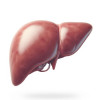
Using HbA1c to Predict the Severity of NAFLD
A recent study published in Diabetes Research and Clinical Practice suggests that glycated hemoglobin (HbA1c), a key measure of glycemic control, may serve as a significant and independent predictor of disease severity in patients with non-alcoholic fatty liver disease (NAFLD).1
Researchers from the UK conducted this study to ascertain the relationship between HbA1c and NAFLD severity in 857 patients with and without type 2 diabetes with liver biopsy staged NAFLD.
The study used a combination of generalized-linear models and binomial regression analysis to investigate the links between disease severity as per histology and factors like age, HbA1c, and BMI. Paired biopsies from interventional studies were used to assess the impact of various factors, such as changes in weight and HbA1c levels, as well as the effectiveness of active treatment versus placebo, on key outcomes like steatosis, non-alcoholic steatohepatitis (NASH), and fibrosis.
Higher HbA1c levels were associated with an increased risk of severe liver disease (steatosis, NASH, and advanced fibrosis), even after adjusting for factors like obesity and age in the discovery cohort of 687 patients. The results were further confirmed in a separate validation cohort of 170.The study's predictive modeling, which combined HbA1c and age, was found to be as effective as fibrosis-4 index (FIB-4) score, a commonly used non-invasive biomarker for NAFLD. This allowed the integration of HbA1c, age, and BMI in creating adjusted risk charts to predict the disease severity.
Following intervention, reductions in HbA1c were independently associated with improvements in both steatosis and NASH, even after adjusting for changes in weight and the effect of treatment. In contrast, improvements in fibrosis were associated only with weight change and the specific intervention or treatment provided and not reduced HbA1c.
The authors noted that current non-invasive scoring systems used to stage the severity of NAFLD do not consider the key markers of glucose control, such as HbA1c. Their study found a significant relationship between raised HbA1c levels and the risk of more severe NASH, which was independent of factors like obesity and age suggesting a role of hyperglycemia in the progression of liver disease. Optimal glycemic control is pivotal in preventing the progression of NAFLD. Hence, HbA1c could be a potential biomarker to identify NAFLD patients at high risk for progression to advanced liver disease and must be incorporated in the routine assessment of patients with NAFLD.
Reference
1. Santo Colosimo, et al. Glycated haemoglobin is a major predictor of disease severity in patients with NAFLD. Diabetes Res Clin Pract. 2024 Aug 13:111820. doi: 10.1016/j.diabres.2024.111820.













Please login to comment on this article